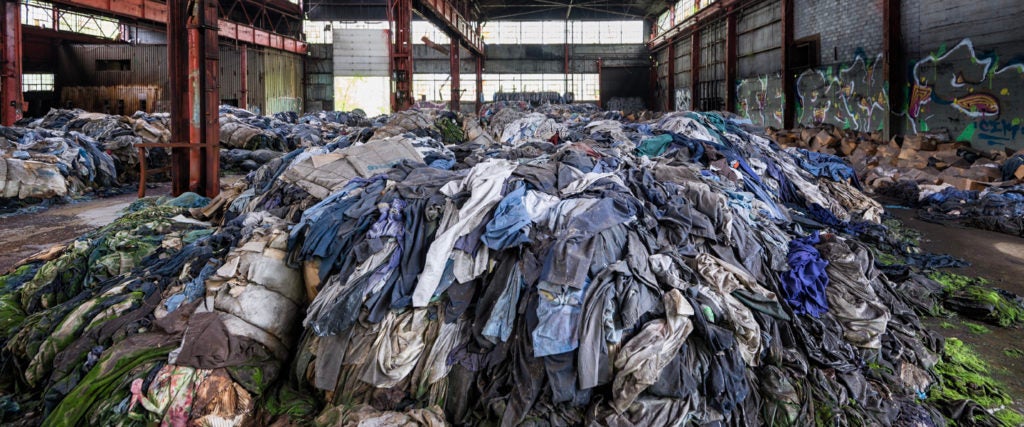Believe it or not, we kind of have a handle on our plastics problem when compared to our out-of-control clothing waste problem. For instance, 29 percent of plastic bottles are recycled compared to just 14.7 percent of clothes and shoes. (For further context, paper and glass have recycling rates of 66 percent and 27 percent respectively.) According to the Environmental Protection Agency, only 2.5 million tons of clothes in the U.S. get recycled every year, meaning the vast majority — more than 85 percent, or 200 million tons — go unrecycled.
How is that possible?
Much of it comes down to what our clothes are made from. The fabrics we cover our bodies with consist of blends of natural yarns, human-made filaments, plastics and metals. To recycle these materials — all of which, after being worn, is called post-consumer waste — takes a lot of effort.
Post-consumer what?
This is the name given to all textiles that are discarded after they’ve been purchased by a consumer. In 1980, the EPA found that the U.S. had generated roughly 5 billion pounds of textile waste. By 2014, that amount had spiked to 32.44 billion pounds.
To be clear, 95 percent of all textiles have the potential to be reused or recycled. The fact that they’re not, though, isn’t only a consumer problem. Pre-consumer waste — or all of the waste generated by businesses that throw away textile bits they don’t use — is also a big issue.
Okay, let’s try this again then — pre-consumer what?
Like I said, it includes all the scraps that are cut away during the manufacturing process. The scale of pre-consumer waste is largely unknown since it’s difficult to track, but estimates suggest that roughly 10 to 30 percent of fabric doesn’t make it into the finished product. The EPA estimates that in 2018, roughly 17 million tons of fabric were produced in the U.S. alone. Based on that number we can pretty confidently predict that up to 5.1 million tons of pre-consumer fabric is wasted every year. And that doesn’t include deadstock or damaged yardage, which is another source of hard-to-measure waste.
Is anyone doing anything about all this pre-consumer waste?
Yes, but they’re few and far between. One good example is Maggie Dimmick, an artist and textile designer in Minneapolis and the founder of Ethel Studio, which uses fabric scraps and damaged garments as their raw material. Per Ethel Studio’s website, they “rescue fabrics from fashion company offices and production facilities and then slowly transform them into products in our zero-waste process.”
Dimmick tells me that she became aware of how much pre-consumer fabric is wasted as a design student. “I witnessed pre-consumer waste firsthand,” she says. “It’s so ridiculous that brands have control over how they use materials, and that they throw away 10 to 30 percent of the fabric that’s cutaway.”
“We collect fabric from local designers in the Twin Cities area,” she continues. “Designers bundle it up into bags for us, and we use it as our own raw material.”
That sounds great. How come more people aren’t doing the same?
Dimmick explains that pre-consumer fabric is based on an entirely different pricing system. “We provide free service to pick up scraps, and we help clothing brands avoid dumping fees,” she says. But that means Ethel Studio is responsible for the higher labor costs of sorting, cutting and sewing the cutaway pieces. Those costs, she admits, are passed down to the consumer. “Our prices aren’t cheap,” she tells me. “Other brands could utilize their own fabric, but a lot of companies opt for the fastest, cheapest way possible, which can be careless.”
Is there any way to make this process more cost-effective?
There is a near infrared-based technology colloquially referred to as Fibersort that’s attempting to sort out this sorting business — at least on the post-consumer waste side of the ledger.
It works by categorizing textiles into different fractions (45 in all at the moment) based on fiber composition and color, and can sort around 2,000 pounds of post-consumer textiles per hour. “We quickly realized that there is a very diverse range of textile products,” Hilde van Duijn, project manager for Circle Economy’s textiles program, told Sustainable Brands last year. Unfortunately, Sustainable Brands also reported that most companies aren’t that interested in using post-consumer textiles to generate new clothes.
WTF. Why?
Similar to the pre-consumer fabric offerings from Ethel Studio, clothes made from recycled fiber and fabrics tend to be more expensive than those from virgin threads. Which is to say, as long as consumers expect their T-shirts to cost $5 a pop, there’s very little chance that recycled clothing will be the next fashion trend.

